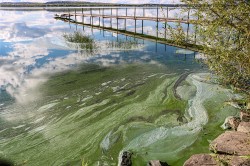Press Release, 29. February 2024
Lake Ecosystems: Nitrogen has been underestimated
Study shows: Algae growth in shallow lakes around the world is affected not only by phosphorus but also by nitrogen
An ecological imbalance in a lake can usually be attributed to increased nutrient inputs. The result: increased phytoplankton growth, oxygen deficiency, toxic cyanobacterial blooms and fish kills. Until now, controls in lake management have focused primarily on phosphorus inputs to counteract this effect. Now, this dogma is shaken by a study performed by the Helmholtz Centre for Environmental Research (UFZ) in collaboration with the University of Aarhus (Denmark) and the University of Life Sciences (Estonia) and published in Nature Communications. The researchers show that nitrogen is also a critical driver for phytoplankton growth in lakes worldwide.

Photo: ss404045-AdobeStock
The input of phosphorus and nitrogen from agricultural sources and sewage treatment plants can have a strong effect on phytoplankton growth in rivers and lakes. "However, it was previously assumed that phytoplankton growth in lakes is mostly limited and driven by the availability of phosphorus," says lead author Dr. Daniel Graeber from the UFZ. The underlying theory: If only small quantities of phosphorus are available in a lake, phytoplankton growth is correspondingly limited. In contrast, large quantities of phosphorous will massively drive phytoplankton growth. "In this explanatory model, nitrogen plays no role," says Graeber. "This is based on the fact that specific cyanobacteria in the water can bind the nitrogen contained in the air and introduce it into the lake. This would therefore preclude a long-term nitrogen deficiency in lakes." Nor could an excess supply of nitrogen promote phytoplankton growth - and therefore could not ultimately give rise to eutrophication. "This model forms the basis for lake management worldwide, where the emphasis has been on controlling phosphorus inputs to counteract lake eutrophication," explains Dr. Thomas A. Davidson, limnologist at Aarhus University and last author of the study. "Reducing phosphorus inputs repeatedly fails to prevent eutrophication. This therefore gave rise to the question of whether the water equation included yet another unknown." In its present study, the research team has now clearly identified nitrogen as such a factor, and is thus indicating new directions for inland water science (limnology) and lake management.
Roughly 89 percent of lakes worldwide are so-called shallow lakes with an average depth of up to six metres. The researchers performed their statistical investigations with long-term monitoring data from 159 shallow lakes in North America, Europe and New Zealand. For each lake, they determined the relationship between the ratio of total nitrogen to total phosphorus and the concentration of chlorophyll-a as a measure of phytoplankton biomass over periods of 5 year. "We wanted to determine the long-term relationships between the ratio of the two nutrients and phytoplankton growth," explains Daniel Graeber. "The idea for our study originated with several outliers in a prior study of the ecology of shallow lakes. In some of the lakes, we did not see a linear correspondence between the measured nutrient and a respective increased or decreased chlorophyll-a concentration," says the limnologist. "We asked ourselves: Could this possibly be due to the nutrient ratio of phosphorus and nitrogen? There had already been a few studies hinting that nitrogen could potentially play a more important role in phytoplankton growth in lakes than was previously assumed."
The statistical analyses in their current study support the theory of these studies and clearly contradict the traditional limnological consensus: 60 percent of the water bodies investigated exhibit a very high probability of a dual-nutrient limitation. This would mean that both nutrients - phosphorous and nitrogen - have a limiting effect on phytoplankton growth in the majority of the lakes. "The relationships were so clear that I couldn't even believe it at first. They corresponded exactly to what was known from laboratory experiments - this was truly astounding," says Graeber. "The result withstood thorough testing of the statistics: The data were robust. Our results confirm the hypothesis that nitrogen is not a passive participant in lake ecology. And we were able to prove with a broad database for the first time that this clearly applies to lakes worldwide." The research team is now spurring further investigations, both in the field and through modelling, with which the results of their data analysis can be tested.
With their study, the researchers have figuratively pulled nitrogen into the equation of lake ecology. They recommend that, in practice, nitrogen now be given more focus in lake management. "We need a long-term investigation of the nutrient ratios to ensure the success of efficient and effective eutrophication management," says Graeber. "This requires a greater focus on inputs from agriculture, which generally have a high nitrogen content."
Publication:
Daniel Graeber, Mark J. McCarthy, TomShatwell, Dietrich Borchardt, Erik Jeppesen, Martin Søndergaard, Torben L. Lauridsen & Thomas A. Davidson: Consistent stoichiometric long-term relationships between nutrients and chlorophylla across shallow lakes; Nature Communications; 2024. https://doi.org/10.1038/s41467-024-45115-3
Further information
Dr. Daniel Graeber
UFZ Department of Aquatic Ecosystems Analysis
daniel.graeber@ufz.de
UFZ press office
Susanne Hufe
Phone: +49 341 6025-1630
presse@ufz.de
In the Helmholtz Centre for Environmental Research (UFZ), scientists conduct research into the causes and consequences of far-reaching environmental changes. Their areas of study cover water resources, ecosystems of the future, environmental technologies and biotechnologies, the effects of chemicals in the environment, modelling and social-scientific issues. The UFZ employs more than 1,100 staff at its sites in Leipzig, Halle and Magdeburg. It is funded by the Federal Government, Saxony and Saxony-Anhalt.
www.ufz.deThe Helmholtz Association contributes to solving major challenges facing society, science and the economy with top scientific achievements in six research fields: Energy; Earth and Environment; Health; Key Technologies; Matter; and Aeronautics, Space and Transport. With some 39,000 employees in 19 research centres, the Helmholtz Association is Germany’s largest scientific organisation.
www.helmholtz.de